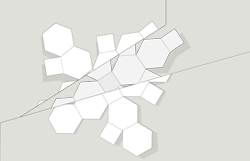

Method
 |
 Method |
| Introductions | The software platform on which we developed the project, Processing, fosters a discourse between so-called "visual" people and "technical" people. It is a language that is well-suited to bridging (unfortunate) knowledge gaps between the humanities and sciences. At the same time Processing is a highly intuitive environment for those trained in the practice of contemporary art, it also is based on technologies that engineers might find beneficial to their research methods. [Our project], being a collaboration between people trained in graphic design, contemporary art, and electrical engineering, is experimental in nature. The process of production is as much a part of the work as the end result; [our project] is about discourse formation in the interdisciplinary context. | |
| Conversations | The initial stages of our work together
began with dialogue; over informal meetings, we would discuss in an open-ended
fashion what our project could be. At first myself, Ben Ritter, and Ashok
Basawapatna were paired together, me as the artist and Ashok as the engineer.
My project idea was to somehow create polyhedra inspired by Buckminster
Fuller through algorithmic visualization. Ashok presented some of his work
with [gyroscopic machines.] After the first day of class, we went to lunch
along with some other of our classmates. During that conversation, Uli Schmidts,
a typographer by training, joined our group. Between talk about rock bands
(Beulah, the Wrens, Pinback) and designers and typefaces (Aksidenz and Tschichold),
we discussed what language we should use to build these polytopes and what
kind of data we could use to produce the visualizations. That is, Ashok
had the idea of using geographic, economic, or demographic information which
the polyhedra would represent. We wanted our project to have a meaningful
relation between the data and form that it visually represents. Initially we thought about using C++ and OpenGL to build our project. Uli then suggested using Java 3d, which is a relatively new technology at the time of writing. Soon, however, we began to work in Processing, which can be seen a synthesis of some of these technologies. Processing, designed by Casey Reas and Ben Fry, is an IDE (integrated design environment) written in Java (which has some similarities to C) and partially implementing the OpenGL library for its three dimensional capabilities. Uli has had some experience in Processing, I had only played around with it a little, and Ashok had never heard of it. Within weeks of deciding on this approach, we came up with our own two-dimensional visualizations that were our initial approaches to figuring out how to build polyhedra. |
|
| Conclusions | After working on several individual projects that investigated different approaches to building virtual polytopes, we began to work together weekly in long collaborative sessions. In these meetings, we did not have rigidly segmented roles; we all shared suggestions, ideas, and knowledge concerning the project and eachother's resepctive disciplines. We let the project grow in an open-ended fashion, yet we made sure that we stayed on course to obtain a concrete result at the end of the research period. | |